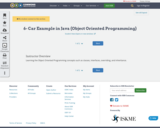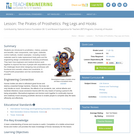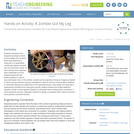
Learning the Object Oriented Programming concepts such as classes, interfaces, overriding, and inheritance.
- Subject:
- Computer Science
- Material Type:
- Full Course
- Author:
- Saeid Samadidana
- Date Added:
- 08/30/2022

Learning the Object Oriented Programming concepts such as classes, interfaces, overriding, and inheritance.

This course is a comprehensive introduction to control system synthesis in which the digital computer plays a major role, reinforced with hands-on laboratory experience. The course covers elements of real-time computer architecture; input-output interfaces and data converters; analysis and synthesis of sampled-data control systems using classical and modern (state-space) methods; analysis of trade-offs in control algorithms for computation speed and quantization effects. Laboratory projects emphasize practical digital servo interfacing and implementation problems with timing, noise, and nonlinear devices.

This activity is an easy way to demonstrate the fundamental properties of polar and non-polar molecules (such as water and oil), how they interact, and the affect surfactants (such as soap) have on their interactions. Students see the behavior of oil and water when placed together, and the importance soap (a surfactant) plays in the mixing of oil and water which is why soap is used every day to clean greasy objects, such as hands and dishes. This activity is recommended for all levels of student, grades 3-12, as it can easily be scaled to meet any desired level of difficulty.

With a focus on the creation of functional prototypes and practicing real magical crafts, this class combines theatrical illusion, game design, sleight of hand, machine learning, camouflage, and neuroscience to explore how ideas from ancient magic and modern stage illusion can inform cutting edge technology.

Virtual meeting spaces have now become integral to modern education and have the potential to make education more accessible, engaging, collaborative and relevant in our rapidly changing world. In this OER we explore how virtual meeting spaces have evolved over the past few decades with an emphasis on the critical role of interfaces in shaping the virtual meeting experience. We investigate what future virtual meeting spaces may look like and attempt to reimagine a future where standards in education are maintained and virtual environments are responsive to learners, society and environmental needs.

Students are introduced to prosthetics history, purpose and benefits, main components, main types, materials, control methods, modern examples including modern materials used to make replacement body parts and the engineering design considerations to develop prostheses. They learn how engineers and medical doctors work together to improve the lives of people with amputations and the challenges faced when designing new prostheses with functional and cosmetic criteria and constraints. A PowerPoint(TM) presentation and two worksheets are provided.

This project-based course explores new design strategies for social interaction in the computer mediated world. Through weekly readings and design assignments we will examine topics such as:
Data-based portraiture
Depicting growth, change and the passage of time
Visualizing conversations, crowds, and networks
Interfaces for the connected city
Mobile social technologies
The course emphasizes developing visual and interactive literacy.

This seminar explores approaches to representation for distributed cinematic storytelling. The relationship between story creation and story appreciation is analyzed. Readings are drawn from literary and cinematic criticism, as well as from descriptions of interactive, distributed works. Students analyze a range of storytelling techniques; they develop a proposal using visualization techniques; and they prototype a working story experience, culminating in a final project displayed at the end of the semester.

Students learn about the basics of molecules and how they interact with each other. They learn about the idea of polar and non-polar molecules and how they act with other fluids and surfaces. Students acquire a conceptual understanding of surfactant molecules and how they work on a molecular level. They also learn of the importance of surfactants, such as soaps, and their use in everyday life. Through associated activities, students explore how surfactant molecules are able to bring together two substances that typically do not mix, such as oil and water. This lesson and its associated activities are easily scalable for grades 3-12.

This course covers principles and methods for technical System Architecture. It presents a synthetic view including: the resolution of ambiguity to identify system goals and boundaries; the creative process of mapping form to function; and the analysis of complexity and methods of decomposition and re-integration. Industrial speakers and faculty present examples from various industries. Heuristic and formal methods are presented. Restricted to SDM (System Design and Management) students.

This course addresses the design of tribological systems: the interfaces between two or more bodies in relative motion. Fundamental topics include: geometric, chemical, and physical characterization of surfaces; friction and wear mechanisms for metals, polymers, and ceramics, including abrasive wear, delamination theory, tool wear, erosive wear, wear of polymers and composites; and boundary lubrication and solid-film lubrication. The course also considers the relationship between nano-tribology and macro-tribology, rolling contacts, tribological problems in magnetic recording and electrical contacts, and monitoring and diagnosis of friction and wear. Case studies are used to illustrate key points.

Students experience the engineering design process as they design and construct lower-leg prostheses in response to a hypothetical zombie apocalypse scenario. Like the well-known Apollo 13 story during which engineers were challenged to fix the crippled spacecraft with limited supplies in order to save astronauts' lives, in this activity, students act as engineers during an imaginary disaster in which a group member's leg was amputated in order to survive a zombie attack. Building on what they learned and researched in the associated lesson, they design and fabricate a replacement prosthetic limb using given specific starting material and limited additional supplies, similar to how engineers design for individuals while working within constraints. A more-advanced scenario challenges students to design a prosthesis that is able to provide a more-specific movement function.